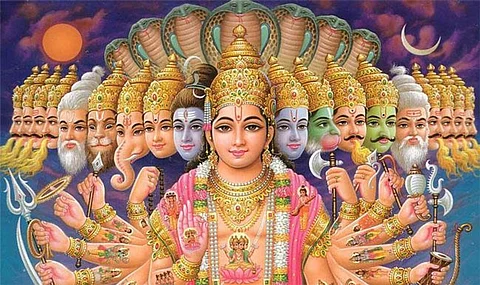
- Home
- NG Hindi
- India
- World
- Politics
- Sex & Relationships
- Entertainment
- Culture
- Lifestyle
- Economy
- Sports
- Sp. Coverage
- Misc.
- NewsGram Exclusive
- Jobs / Internships

By Nithin Sridhar
In the last few installments of this series, various tenets of Dharma (duty/righteousness) like Ahimsa (non-injury), Daya (compassion), and Kshama (forgiveness) were explained. In this installment, let us delve deep into the topic of Ishwara or Brahman from the Hindu aspect that is usually translated in English as God.
The concept of God or the Almighty has been a matter of debate all over the world from early times of mankind. Various religions, philosophies, and even scientists have tried to answer questions regarding this Supreme Being. Though most people agree with the definition of God as one who is Supreme Almighty, there are many huge irreconcilable differences between the concepts of God of the Dharmic traditions and the Abrahamic religions.
Please Follow NewsGram on Facebook To Get Latest Updates!
Any discussion surrounding the topic of God and His/Her/Its existence ultimately boils down to three questions:
God is present everywhere and in the heart of all creatures. Pinterest
Let's take up only the second question: "Where is God?" in this installment.
In the Isha Upanishad, the very first mantra (verse) gives an answer to this question. It says:
This translates into God has a habitat everywhere. So, to the question "Where is God?" the Isha Upanishad answers that God is present everywhere and in all objects of the Universe. Accordingly, from a tiny blade of grass to a big mountain, God is omnipresent. This understanding can be more profoundly understood by the event of Prahlada and Hiranyakashipu as mentioned in Puranas. When demon Hiranyakashipu asked his son whether God is in the pillar? Prahlada replied in positive. When Hiranyakashipu tried to break the pillar, God in the form of Narasimha came out of the pillar and slayed the demon.
The gist of the incident is that God is everywhere, in all sentient and non-sentient objects. He is in the rocks, the wind, the planets, the star, the space, the microbes, the plants, the animals or even in humans. The next question that may immediately arise is: When it is said God is in humans, plants, or objects, where exactly is the God located in them?
So, Lord Krishna says God is located in the hearts of all. Here "Hrdii" that is translated as "Heart" does not refer to physical heart. The non-living objects don't have a physical heart! The "Hrdii" refers to the central essence of an individual's existence. This can be better understood with an example.
Every circle has a center. The center is the essence of the circle. It is not only the most important portion of the circle but also the very origin of the circle. In fact, the dot which represents the center can be considered as a circle in itself but with "zero" or "near zero" radius. From this perspective, a circle with any radius is nothing but a "zero radius circle" (i.e. the center) whose radius has been increased to form a particular circle with a particular radius.
Lord Krishna says in the Bhagwad Gita,"I am the father of the universe and I am present everywhere". Pinterest
Similarly, "Hrdii" or "Hradayam" does not refer to a physical heart, but to the center of "individual's existence" of any object living or non-living. So, even though God is present everywhere and in all objects, He can be fully and directly perceived and realized in the "Hradayam" of all creatures.
How exactly this realization could be gained is a topic for another article. But it is sufficient to say that from one school of thought in Hinduism, God who is actually called as Ishwara or Brahman (each term has a specific meaning and context) in Hinduism is not some superman kind of existence present in heaven or something. Instead, God is present everywhere and in the heart of all creatures.
More in this segment:
Gleanings from Hindu Scriptures- Part 1
Gleanings from Hindu Scriptures- Part 2
Gleanings from Hindu Scriptures- Part 3
Gleanings from Hindu Scriptures- Part 4
Gleanings from Hindu Scriptures- Part 5
Gleanings from Hindu Scriptures- Part 6
Gleanings from Hindu Scriptures- Part 7
Gleanings from Hindu Scriptures- Part 8
Gleanings from Hindu Scriptures – Part 9
